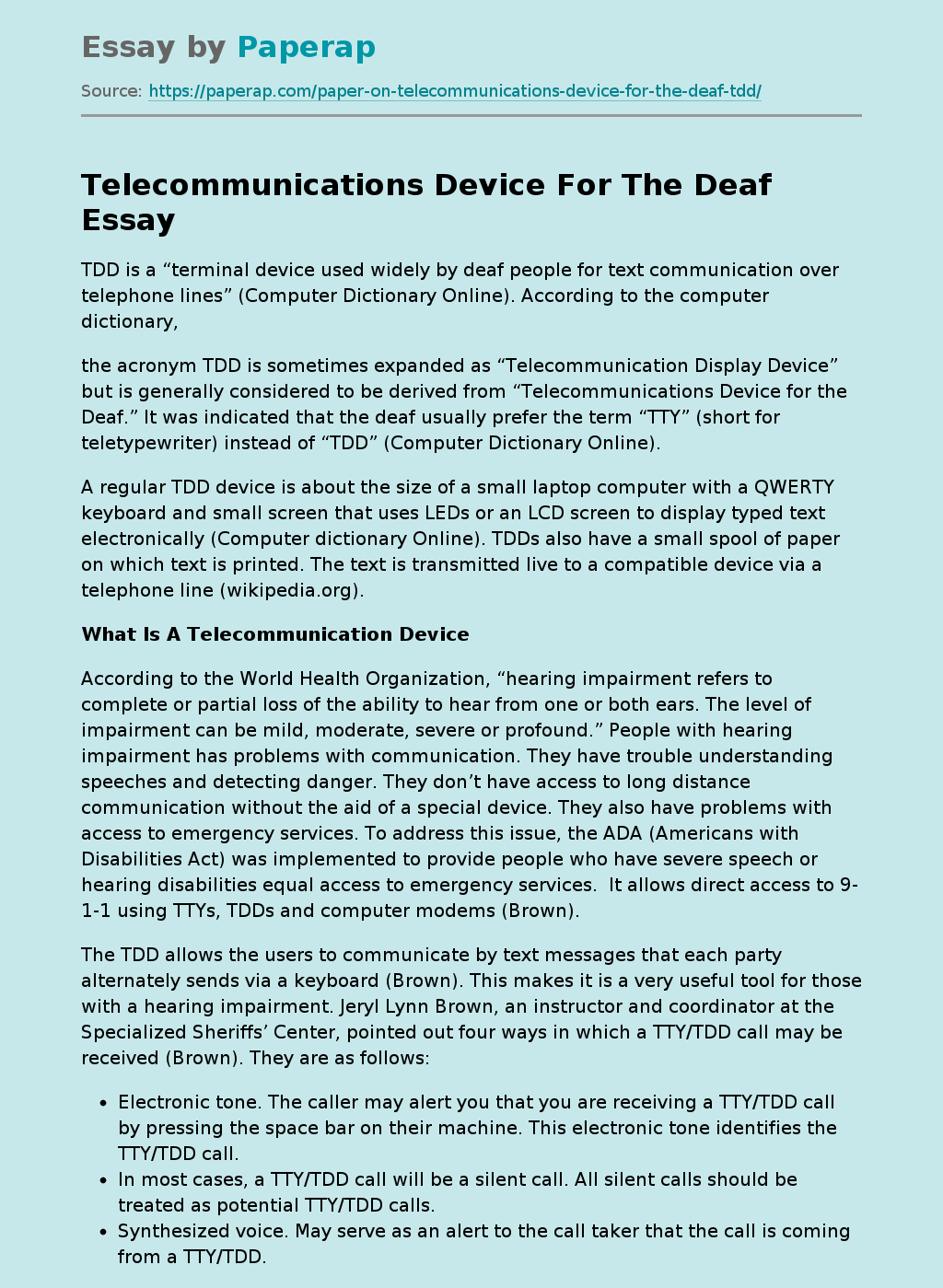Telecommunications Device For The Deaf
TDD is a “terminal device used widely by deaf people for text communication over telephone lines” (Computer Dictionary Online). According to the computer dictionary,
the acronym TDD is sometimes expanded as “Telecommunication Display Device” but is generally considered to be derived from “Telecommunications Device for the Deaf.” It was indicated that the deaf usually prefer the term “TTY” (short for teletypewriter) instead of “TDD” (Computer Dictionary Online).
A regular TDD device is about the size of a small laptop computer with a QWERTY keyboard and small screen that uses LEDs or an LCD screen to display typed text electronically (Computer dictionary Online).
TDDs also have a small spool of paper on which text is printed. The text is transmitted live to a compatible device via a telephone line (wikipedia.org).
What Is A Telecommunication Device
According to the World Health Organization, “hearing impairment refers to complete or partial loss of the ability to hear from one or both ears. The level of impairment can be mild, moderate, severe or profound.
” People with hearing impairment has problems with communication. They have trouble understanding speeches and detecting danger. They don’t have access to long distance communication without the aid of a special device. They also have problems with access to emergency services. To address this issue, the ADA (Americans with Disabilities Act) was implemented to provide people who have severe speech or hearing disabilities equal access to emergency services. It allows direct access to 9-1-1 using TTYs, TDDs and computer modems (Brown).
The TDD allows the users to communicate by text messages that each party alternately sends via a keyboard (Brown). This makes it is a very useful tool for those with a hearing impairment. Jeryl Lynn Brown, an instructor and coordinator at the Specialized Sheriffs’ Center, pointed out four ways in which a TTY/TDD call may be received (Brown). They are as follows:
- Electronic tone. The caller may alert you that you are receiving a TTY/TDD call by pressing the space bar on their machine. This electronic tone identifies the TTY/TDD call.
- In most cases, a TTY/TDD call will be a silent call. All silent calls should be treated as potential TTY/TDD calls.
- Synthesized voice. May serve as an alert to the call taker that the call is coming from a TTY/TDD.
- A relay announcement may come in, which serves to notify the call taker that the call is from a TTY/TDD or computer modem.
In addition to this, the TDD could be used to place calls to a Telecommunications Relay Service (TRS). The TRS “allows a TTY/TDD user and a traditional telephone user to communicate through the telephone network via a communication assistant who serves as a conduit to relay information between the parties” (Brown). It is not advisable for those who have hearing disabilities to use this service in the case of an emergency, due to the delay that may be caused in relaying the information (Brown).
J.L. Brown pointed out some issues and risks regarding the use of this device. The first issue worth mentioning is that members of the speech and hard of hearing communities usually do not converse frequently with persons outside of their communities. As a result, several problems can occur when communicating with this special population. The second issue is that the user may not be very familiar with the TTY/TDD machine. This could lead to slow communications and to an increased distress level of the caller. The third issue is that the caller cannot be interrupted while they are transmitting.
This would pose a problem if they are transmitting long and unnecesary messages. The fourth issue is based on the clarity of communication. The language of a person with a hearing impairment is not based on English syntax word order because English is only their second language. As a result, their sentences will not be grammatically correct. The last issue that needs to be addressed is that a telecommunicator should avoid using English idioms such as “hold,” “stay on the line” or “passed out.” This is because the hard of hearing and speech-impaired people may not be familiar with slang and expressions, and may end up taking it literally.
Before the invention of the TTY/TTD, there was no other device that provided the same type of service for the deaf and the hard of hearing. The use of instant long distance communication was a problem for them. The only popular options are amplifier devices such as amplifier handsets (for public phones), telephone handsets, and portable amplifiers that can be used to boost up the volume of telephones (Laurent Clerc National Deaf Education Center, 2001).
References
- Brown, J.L. (N.D.). What is TTY and TDD? Retrieved December 26, 2007 from North Carolina Justice Academy database (NCJA).
- Computer Dictionary Online. (2007). Telecommunications Device for the Deaf. Retrieved. December 26, 2007 from Computer-Dictionary-Online.org database.
- DiPietro, L., Williams, P., Kaplan, H. (2001). Alerting and Communicating Devices for Deaf and Hard of Hearing People—What’s Available Now. Retrieved December 26, 2007 from Laurent Clerc National Deaf Education Center database.
- Wikipedia. (2007, December 22). Telecommunications Device for the Deaf. Retrieved December 26, 2007 from Wikipedia.org database.
Telecommunications Device For The Deaf. (2019, Dec 05). Retrieved from https://paperap.com/paper-on-telecommunications-device-for-the-deaf-tdd/

